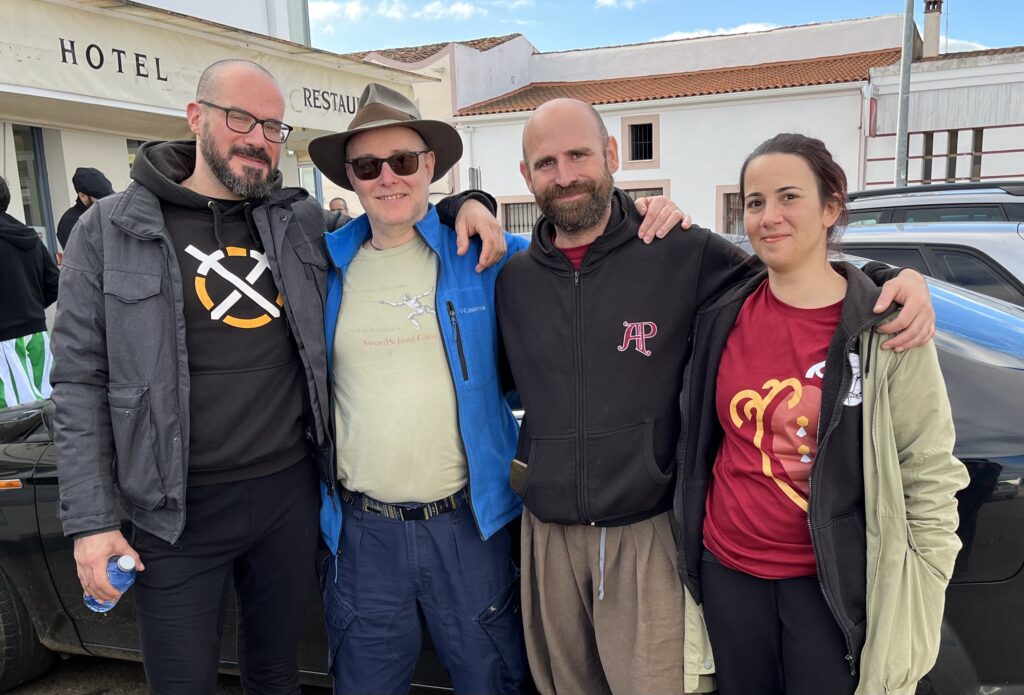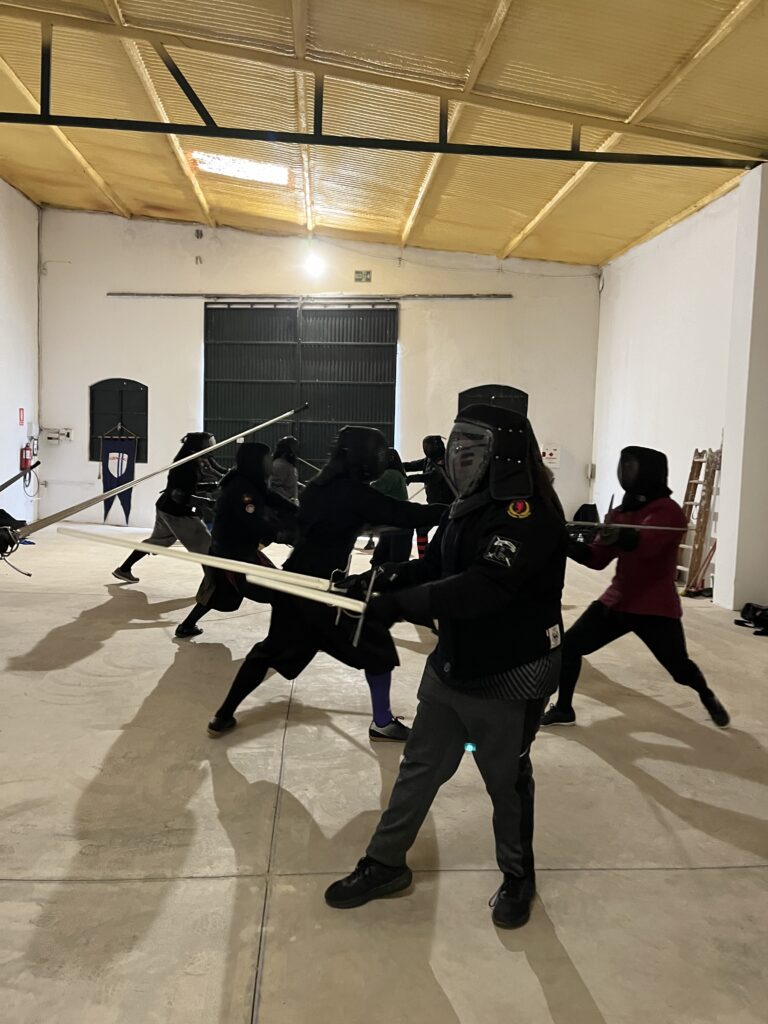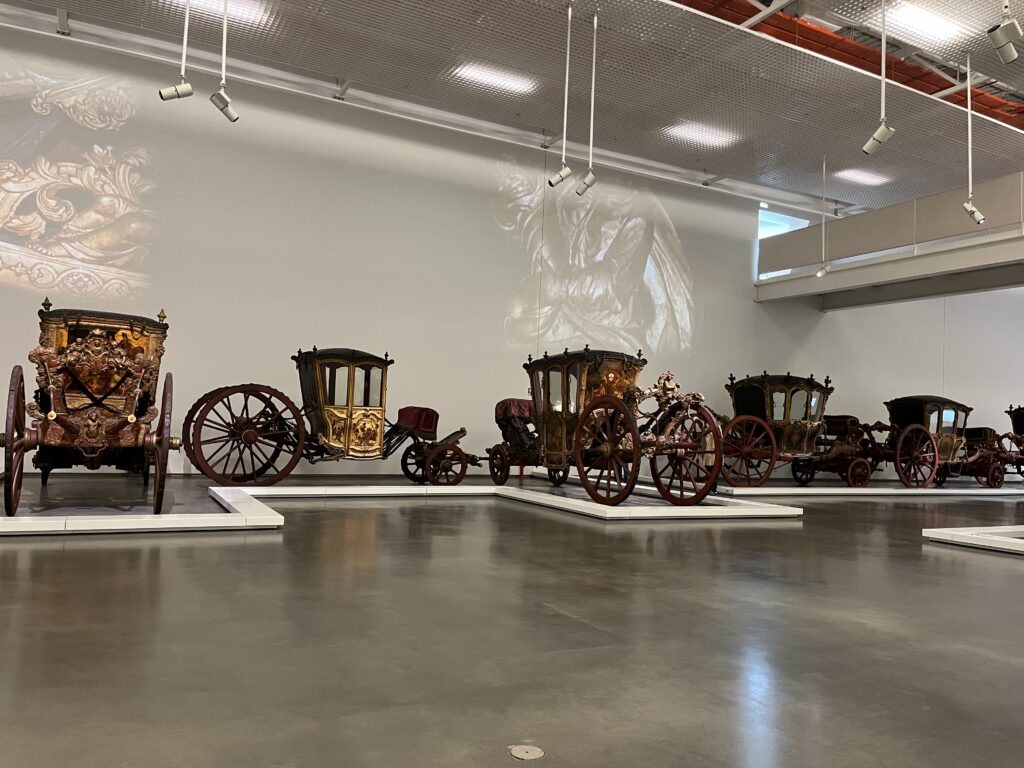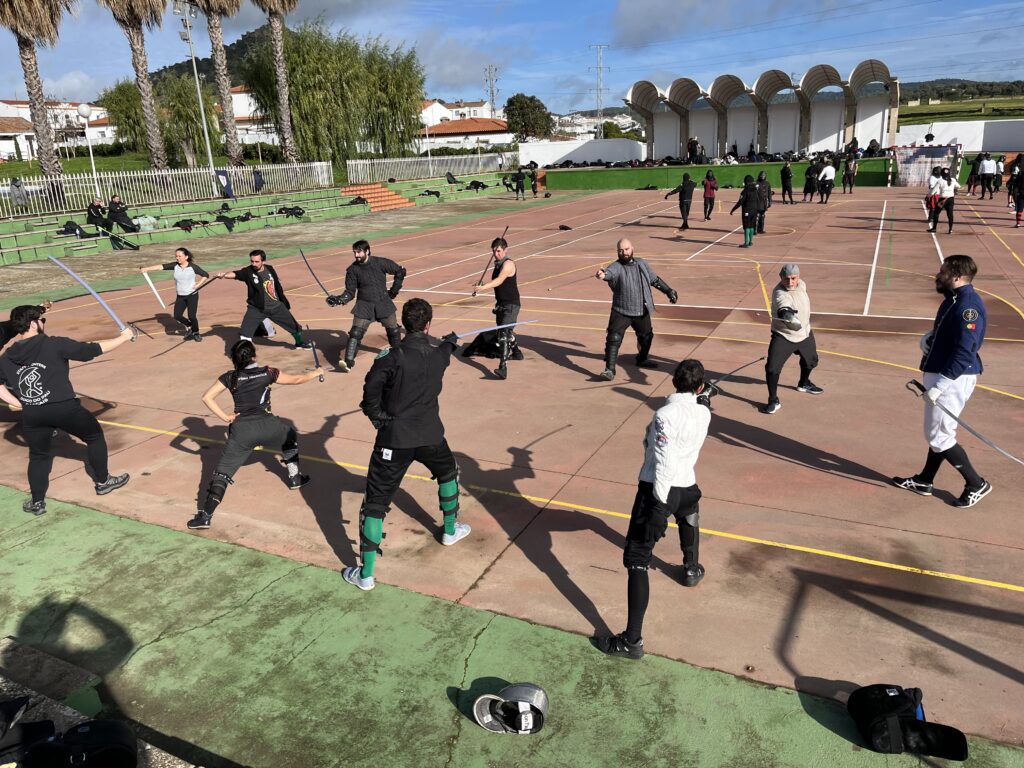I’m just back from the Panóplia Iberica, held in Alconchel, a village in Spain near the border with Portugal. This was an utterly delightful event, all the more impressive for being the first time it has been run. Hats off to the organisers Pedro Velasco, whom I met in Warsaw in June; Jessica Gomes, whom you may recall from episode 38 of the podcast, and who also looked after me in Lisbon before and after the event; and Diniz Cabreira, from episode 157, who runs AGEA Editora, publishing historical martial arts books, primarily on La Verdadera Destreza in Portuguese.

Every event has its own character, and its own strengths and weaknesses. The primary strength of this one was the tone in which everything was conducted. The organisers made it very clear what sort of behaviour they wanted. Collegial; friendly; competitive when fencing, perhaps, but in the spirit of seeking after truth, not climbing the hill of renown over the injured bodies of your opponents. There were a lot of attendees- it felt like something north of a hundred, many of whom taught classes or gave lectures in addition to attending classes and fencing a lot.
There was a lot of fencing. Everywhere you looked, all the time, there were people crossing swords. With so many hundreds of fencing hours, it’s astonishing that there were no injuries, and no falling out. I didn’t see a single disgruntled fencer at any point over the three days. Anyone who has been to a fencing event will know how unlikely that is. Fencers have egos, and fencing instructors have bigger egos. (Ask me how I know.)
Just one example: a smallsword instructor was disarmed three times by another smallsword instructor in friendly but competitive fencing. You might expect a bit of wounded pride there. But all I heard in his voice was a kind of glee to have been shown an area he could improve on, and respect and admiration for his opponent.
This is how it ought to be. And it didn’t happen by accident. Pedro, Jessica, and Diniz deliberately created the environment in which that attitude was natural. It started with a short introduction from Pedro, followed by an entire class, the only one in that first time slot on Friday morning, in which Pedro instilled the attitude in the attendees. I wasn’t paying close attention to the class because I was eyes-deep in the best Fiore nerd-athon discussion I’ve had in years (more about that later), and I wondered at the time why Pedro was running such a general and somewhat odd session. Then it dawned. He wasn’t trying to teach them a particular martial art. He was getting them to behave the way he wanted the event to run.
My own classes went well, I thought. I was invited because Pedro happened to be sitting across from me while I was chatting with Ton Puey (who sadly couldn’t attend this event) about creating scalable assets (like books and courses) and making passive income (so if you’re ill or injured you can still pay the bills). So on Friday night I gave a talk about how to make a living as a historical martial arts instructor. I plan to write that up properly, as it’s probably useful to a lot of people who run clubs, and are thinking about turning pro, or who are already scraping a living teaching the noble art. I focussed on models and strategy, not specifics, because the specifics change greatly depending on your location, goals, and style. In the meantime, my not-terribly detailed presentation slides are in a pdf for you here:
My second session was a rapier and dagger class on how to teach students to get comfortable using the dagger, and avoiding their opponent’s.

You can find the basic content in section four of the Complete Rapier Workbook. The class went pretty well, I thought, with a range of experience levels in the students, from ‘never used a sword and dagger together before’ to ‘have taught rapier and dagger for years’, all of whom were a delight to have in class.
My goal when attending events like this is to make sword-friends, teach good classes, and to help at least one student make a game-changing breakthrough. As always, this mostly happens between classes, in the conversations and spontaneous private lessons that occur.
Such as passing a student who was practising something that looked a little bit like my Farfalla di Ferro drill, and spending some time with him getting it actually correct (Ibrahim, I’m expecting that video next month of you doing it flawlessly!).
Or spotting a mechanical error in a student’s lunge that would lead to injury eventually, and spending time with her correcting it (Anna, keep your knee tracking your foot, okay?).
Or showing the instructor who got disarmed three times a tiny adjustment to the way he was holding his sword that would dramatically improve his control over it (give it the finger, Rui).
Perhaps my most useful interaction, in terms of my fencing, was the aforementioned nerd-athon in which Dario Alberto Magnani blew my tiny mind with a re-reading of a critical passage in the Getty manuscript. I will certainly be writing up what happened in depth and detail, but it will take a little while as I need to run it by him before publishing to make sure that I’m representing his position properly, and I need time to figure out how much of his position I actually agree with. There is nothing better in academia than finding the ground you’ve built on starting to shift under your feet. Watch this space…
It’s impossible to mention everyone who made a positive difference- there were so many! But I’d be remiss to not also thank Rui for long conversations about art and British sabre; Christina for showing me her astonishing paintings and making sure I knew where the wheatless food was; Dario (again) for discussing the business side of running the Thokk gloves empire; the entire Mexican contingent (Anna, Jorge, Sebas, Adrian, Yakimi and Eduardo) for making me even more excited to visit Mexico next year (it’s planned for March); Alex the vintner behind Portos dos Santos port (of which I now have a bottle in my house) for discussions about wine making and history, Ricardo Macedo for continuing a conversation and friendship that began in lockdown; and the list goes on.
All this in addition to spending some quality tourist time in Lisbon. Jessica picked me up from the airport and we went straight to the Gulbenkian museum for a spot of lunch and a massive art injection. It’s a truly fabulous collection, which while light on swords and armour, is really heavy on gorgeous furniture, paintings, sculpture, and tapestries. And a clock from 1745 that’s still running.
And an Assyrian relief sculpture that practically knocked me on my arse.

The next day I went for a wander on my own, and ended up in the Coaches museum. It’s an extraordinary collection of magnificent coaches, with incredible craftsmanship, housed in a state-of-the-art new museum building. And it’s a crap museum. The coaches are just sitting there, like they’re parked in a warehouse. There is no sense of flow, or mystery, or history, or discovery, or story.

That evening we drove off to the Panóplia, and got back on Sunday evening. I was on the last flight home on Monday, so Jessica very kindly took me into the centre and we touristed the place up. (Yes, that’s a verb.) The view from the top of the Arco da Rua Augusta was superb, and lunch in a fabulous little restaurant that you’d never find without a guide was a cultural and gastronomic delight. Get this: they set fire to their sausages!

There is nothing like wandering around a city to get a feel for the place. And having a glass of Ginja from the same little shop where Manuel dos Reis da Silva Buíça had a dram before heading off to shoot Carlos I (the last reigning King of Portugal; his younger son Manuel was technically king, but in exile, which in my view doesn’t count unless you mount a successful counter-revolution) in 1908. I’m happy to say that I’m feeling no more regicidal after the ginja than I was before.
So to everyone who made the trip such a spectacular success: gracias, grazie, obrigado, and thank you!

